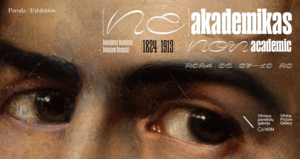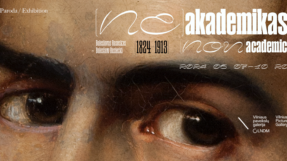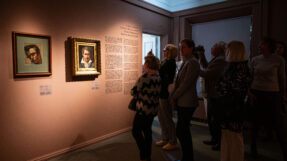The upcoming exhibition at Vilnius Picture Gallery of the LNMA will introduce its visitors to the unduly forgotten Lithuanian artist Boleslovas Ruseckas
Exhibition opening at 5.30 pm Tuesday, 7 May, 2024
 At 5.30 pm Tuesday, 7 May, Vilnius Picture Gallery of the LNMA opens an exhibition (Non)academic. Boleslovas Ruseckas, commemorating the artist’s 200th birth anniversary. It is the first such as inclusive presentation of the life and art of the Lithuanian artist of Roman birth, Boleslovas Ruseckas. The exhibition will run until 20 October.
At 5.30 pm Tuesday, 7 May, Vilnius Picture Gallery of the LNMA opens an exhibition (Non)academic. Boleslovas Ruseckas, commemorating the artist’s 200th birth anniversary. It is the first such as inclusive presentation of the life and art of the Lithuanian artist of Roman birth, Boleslovas Ruseckas. The exhibition will run until 20 October.
“The about- to-open exhibition of Boleslovas Ruseckas not only familiarizes with the heritage of Lithuanian art, offering a chance to relish in precise painter’s brushwork; it invites also to discover the artist as a personality shaped by the tension between his desire to embody the academic laws and an overpowering passion to adopt a free manner of painting. It is joyful that the curators have prepared a special feast to the eyes of professionals and art lovers,” Dr Arūnas Gelūnas, director general of the LNMA, introduces the protagonist of the exhibition.
“This exhibition is one of the steps in the long-term strategy of Vilnius Picture Gallery of the LNMA. Exhibitions dedicated to a single artist serve to introduce the golden collection of Lithuanian art and to suggest a fresh look at our artists, to make them easier recognizable, bring them closer and make more relevant to contemporary viewers. Boleslovas Ruseckas is among such figures. His rich legacy, his artwork and his writings, safekept by the museums and archives, and the latter almost unresearched, is badly in need of rediscovery. The abundance of documents and sketches on display may come unexpected to the visitors, but we wanted to demonstrate an especially rare opportunity this artist offers of entering his life beyond his studio, which shines a light on the context that gave rise to his artwork,” Dr Aistė Bimbirytė, director of Vilnius Picture Gallery, claims.
Talented, multifaceted and unduly forgotten
Until now many a lover of the ancient Lithuanian art knew Boleslovas Ruseckas only as the son of one of the leading 19th century artists, Kanutas Ruseckas (Kanuty Rusiecki,1800–1860), whose brush we owe the celebrated Reaper. The artistic legacy of the artist, collector, public figure Boleslovas Ruseckas was previously presented only in parts at small scale events of 1993, 2001 and 2014, which introduced the visitors into his album of drawings, one work on religious theme and the views of Italy.
The idea of the first retrospective of Boleslovas Ruseckas was inspired by the artist’s 200th birth anniversary. The curators of the retrospective explored this opportunity to research his artistic and literary legacy in the Lithuanian and foreign memory institutions as well as in private collections and to present it to the public.
The viewers will follow his life and art story through eight exhibition rooms, learning of his personality from the start of his creative career, his studies in St Petersburg, his Italy period, his search for artistic solutions and results, and his public, private and creative milieu.
The entirety of his artistic creation, assembled of different parts, retraces his complex creative process from the conception stage to its final result, highlighting also an intimate relationship with his subject developed throughout the process.
The artist worked combining the academic and realistic styles. He produced religious and allegorical compositions, as well as portraits, he sketched his daily surroundings. His fragmentary legacy, helps, however, to learn more intimately about the painter’s work from inside, to take a look at his lost or as of yet unidentified big compositions at their initial stage.
The talented, multifaceted and unduly forgotten artist – this is how Vilnius Picture Gallery of the LNMA presents Boleslovas Ruseckas.
The life in the father’s shadow and the desire for an academic career
For Boleslovas Ruseckas, inspiration and beauty, which “he wanted to swallow with his eyes” were everywhere – in the countenance of his beloved, in the figures of Italian peasants, in the courtyards of the Old Town of Vilnius and the foliage of an ancient forest. Art was his life. When he stepped out of the studio, he delved into the history of art. He was especially fascinated with the ancient Italian masters, with the Nazarenes; his contemporaries valued him as the top expert of Vilnius Art School, whose works and photographic reproductions were in his collection.
According to the curators of the exhibition, his artistic legacy and his letters hint at the tensions which seem to have been impossible to escape. The artist educated by his father, one of the most famous Lithuanian artists of the 19th century, Kanutas Ruseckas, found it difficult to step out of his father’s shadow. Based on his artistic education, and his personal concept of art, he associated with the academic trend, but his attempts to win the name of an academic painter were thwarted. Even more, large scale compositions, common for academic painters, exhausted him; the artist experienced great pleasure and inspiration as soon as he dropped the strict rules, with which he struggled to comply with by painting landscapes, small size portraits, light and vibrant sketches.
The artist’s career years
Boleslovas Ruseckas was born in Rome and spent his childhood there. He was seven, when his parents moved to Lithuania. Vilnius and his father Kanutas were the strongest influence on his early art. His albums of sketches with plenty of panoramas of Vilnius, views of the city’s highlights, cityscapes, portraits of his family members, of unknown individuals, still lifes, life drawings testify to these influences. His early drawings show that he learned also by copying the lithographic prints by foreign graphic artists and the paintings by his father.
In 1843 – 1850, he studied as a student auditor at St Petersburg Art Academy. During studies, he created lithographic prints and painted portraits. In 1850, his portraits from life earned him the name of an independent artist. His Self Portrait painted after his studies, is one of the best of his work. In 1853, he painted an allegoric composition Connecting the Neris with the Nemunas River and received the status of a candidate to academicians.
After completion of his studies, he appealed for a permission to travel abroad, but was able to receive it only in 1857. The artist toured Warsaw, Krakow, Drezden, Prague, Vienna, Trieste, Ancona, and spent three years in Rome. The locations he visited on his journey, the monuments of architecture and art, the scenes of Italian daily life and the colourful national costumes were captured by him in sketchbooks. His father received letters describing Boleslovas’s impressions.
The time in his childhood’s city turned for the artist deeply uplifting. He visited nearly all of Rome’s museums, galleries, churches, he went to the artists’ studios, made copies of paintings, drew and painted sketches from life. In the evening, he went to the academy for life drawing, at daytime, he worked in his studio. At the time he worked on his paintings The Death of Bolesław the Brave and The Assumption of the Blessed Virgin Mary.
The artist was interested in history and in the past of his country, he collected archaeological finds, historic treasures, and was an outstanding copier and expert of the ancient masters, especially Italian, and a passionate researcher of Vilnius Art School. Over the long years, he accumulated a collection – testament to these interests of his. It included works, which were deemed original Guido Reni, Sassoferrato, Caraccio, Rossio, Mario de Fiori as well as copies of Leonardo da Vinci, Raphael, Veronese, Rubens, Tizian, also works by Vilnius artists, Pranciškus Smuglevičius, Simonas Čechavičius, Vincentas Dmachauskas and others. A part of Boleslovas Ruseckas’s collection will be available to see as part of the exhibition, in one dedicated exhibition room.
The exhibition at Vilnius Picture Gallery of the LNMA will be accompanied by an educational programme: public lectures by art historians, tours with the exhibition curators and museum guides, education events for pupils, adults, families and the elderly.
Organiser: Vilnius Picture Gallery of the LNMA
Exhibition curators: Aistė Bimbirytė, Gabija Kasparavičiutė-Kaminskienė, Dalia Tarandaitė, Joana Vitkutė
Architecture: MOA
Designer: Elena Kanarskaitė
Project financed by: Ministry of Culture of the Republic of Lithuania
Information partner: LRT Plius
Sponsor: Audėjas
Partners: The Wroblewski Library of the Lithuanian Academy of Sciences, Lithuanian National Museum, Krakow National Museum, Lithuanian State Historical Archives, Dr Jaunius Gumbis, M. K. Čiurlionis National Museum of Art
4 Didžioji st, Vilnius, Lithuania
+370 5 261 1685
vpg@lndm.lt















